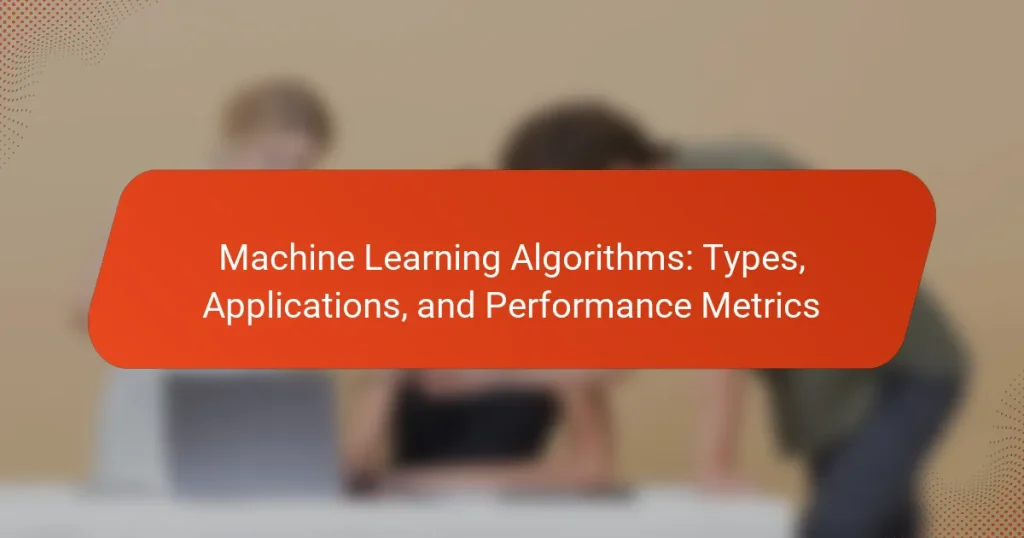Machine learning algorithms are computational methods that enable systems to learn from data by identifying patterns and making decisions without explicit programming. These algorithms are categorized into three main types: supervised learning, unsupervised learning, and reinforcement learning, each serving distinct purposes across various applications such as image recognition, natural language processing, and recommendation systems. The performance of these algorithms is evaluated using metrics like accuracy, precision, recall, F1 score, and area under the ROC curve (AUC-ROC), which quantify their effectiveness. However, challenges such as data quality, the need for large datasets, overfitting, interpretability, computational resource demands, and algorithmic bias can impact their performance. Understanding these elements is crucial for effectively implementing machine learning solutions.

What are Machine Learning Algorithms?
Machine learning algorithms are computational methods that enable systems to learn from data. They identify patterns and make decisions without explicit programming. These algorithms can be categorized into supervised, unsupervised, and reinforcement learning. Supervised learning uses labeled data to train models, while unsupervised learning identifies hidden patterns in unlabeled data. Reinforcement learning optimizes actions based on feedback from the environment. Machine learning algorithms are widely used in applications such as image recognition, natural language processing, and recommendation systems. According to a report by McKinsey, companies that adopt machine learning can increase productivity by up to 30%.
How do Machine Learning Algorithms function?
Machine learning algorithms function by analyzing data to identify patterns and make predictions. They utilize statistical methods to learn from input data. The learning process involves training on a dataset, where the algorithm adjusts its parameters. This adjustment minimizes the difference between predicted outputs and actual outcomes. Algorithms can be supervised, unsupervised, or semi-supervised. Supervised algorithms learn from labeled data, while unsupervised algorithms find structure in unlabeled data. The effectiveness of these algorithms is evaluated using performance metrics, such as accuracy and precision. Research shows that algorithms like decision trees and neural networks are widely used in various applications.
What are the key components of Machine Learning Algorithms?
The key components of machine learning algorithms include data, features, models, and evaluation metrics. Data serves as the foundational input for training algorithms. Features are the individual measurable properties used by the model to make predictions. Models represent the mathematical framework that learns patterns from the data. Evaluation metrics assess the performance of the model, determining its accuracy and effectiveness. These components work together to enable machine learning systems to learn and improve over time.
How do data and algorithms interact in Machine Learning?
Data and algorithms interact in machine learning through a process of training and prediction. Data serves as the foundational input that algorithms use to learn patterns. During the training phase, algorithms analyze large datasets to identify relationships and make predictions. The quality and quantity of data directly influence the algorithm’s performance. Algorithms adjust their parameters based on the data to minimize errors in predictions. This iterative process continues until the model reaches an acceptable level of accuracy. For instance, supervised learning algorithms require labeled data to learn effectively. In contrast, unsupervised learning algorithms work with unlabelled data to find inherent structures. Ultimately, effective interaction between data and algorithms leads to improved decision-making and insights.
What are the different types of Machine Learning Algorithms?
The different types of machine learning algorithms include supervised learning, unsupervised learning, semi-supervised learning, and reinforcement learning. Supervised learning algorithms use labeled data to make predictions. Examples include linear regression and decision trees. Unsupervised learning algorithms identify patterns in unlabeled data. Clustering and association are common techniques in this category. Semi-supervised learning combines both labeled and unlabeled data for training. Reinforcement learning focuses on making decisions through trial and error to maximize rewards. Each type serves different purposes in data analysis and predictive modeling.
What is supervised learning and how does it work?
Supervised learning is a type of machine learning where an algorithm is trained on labeled data. In this process, the model learns to map input data to the correct output based on examples provided during training. The labeled data consists of input-output pairs, where the input is the data and the output is the desired result.
During training, the algorithm adjusts its parameters to minimize the difference between its predictions and the actual outputs. This is often achieved using techniques such as gradient descent. Once trained, the model can make predictions on new, unseen data.
Supervised learning is commonly used in applications like classification and regression. In classification, the model predicts discrete labels, while in regression, it predicts continuous values. Popular algorithms include linear regression, decision trees, and support vector machines. The effectiveness of supervised learning can be measured using metrics such as accuracy, precision, and recall.
What is unsupervised learning and what are its applications?
Unsupervised learning is a type of machine learning that analyzes and identifies patterns in data without labeled outcomes. It enables algorithms to learn from input data without supervision. Common techniques include clustering and dimensionality reduction. Applications of unsupervised learning are diverse. They include customer segmentation in marketing, anomaly detection in fraud prevention, and image compression in computer vision. For example, clustering algorithms like K-means help businesses group customers based on purchasing behavior. Dimensionality reduction techniques such as PCA are used to simplify data while retaining essential information. These applications demonstrate the effectiveness of unsupervised learning in extracting insights from large datasets.
What is reinforcement learning and why is it important?
Reinforcement learning is a type of machine learning where an agent learns to make decisions by taking actions in an environment to maximize cumulative rewards. It is important because it enables machines to learn optimal behaviors through trial and error. This learning approach is widely applied in various fields, including robotics, gaming, and autonomous systems. For instance, AlphaGo used reinforcement learning to defeat human champions in the game of Go, showcasing its capability to solve complex problems. Reinforcement learning algorithms can adapt to dynamic environments, making them valuable for real-time decision-making tasks.
What are the common applications of Machine Learning Algorithms?
Common applications of machine learning algorithms include image recognition, natural language processing, and predictive analytics. In image recognition, algorithms identify and classify objects in images. This technology is widely used in [censured] recognition systems. Natural language processing enables machines to understand and respond to human language. Applications include chatbots and language translation services. Predictive analytics uses historical data to forecast future trends. Industries such as finance and healthcare utilize this for risk assessment and patient diagnosis. Machine learning algorithms also power recommendation systems in e-commerce platforms. These systems analyze user behavior to suggest products. Overall, machine learning algorithms are integral to various sectors, enhancing efficiency and decision-making.
How are Machine Learning Algorithms used in healthcare?
Machine learning algorithms are utilized in healthcare to enhance diagnosis, treatment, and patient outcomes. These algorithms analyze vast amounts of medical data to identify patterns and make predictions. For example, they can predict disease outbreaks by analyzing patient records and environmental data. Machine learning is also applied in imaging analysis, where algorithms help radiologists detect abnormalities in scans more accurately. Predictive analytics is another application, aiding in patient risk assessment and personalized treatment plans. Research has shown that machine learning can improve diagnostic accuracy by up to 20% compared to traditional methods. Additionally, algorithms facilitate drug discovery by analyzing biological data to identify potential drug candidates. Overall, the integration of machine learning in healthcare leads to more efficient processes and improved patient care.
What role do Machine Learning Algorithms play in finance?
Machine learning algorithms play a crucial role in finance by enhancing decision-making processes. They analyze vast amounts of financial data to identify patterns and trends. These algorithms improve risk assessment and management. For instance, they can predict market movements with higher accuracy than traditional methods. Machine learning models are utilized in algorithmic trading to execute trades at optimal times. They also assist in fraud detection by recognizing unusual transaction patterns. Additionally, these algorithms personalize financial services for clients based on their behaviors. A study by Deloitte indicates that financial institutions using machine learning can reduce operational costs by up to 30%.
How do Machine Learning Algorithms enhance marketing strategies?
Machine learning algorithms enhance marketing strategies by enabling data-driven decision-making. They analyze vast amounts of consumer data to identify patterns and trends. This allows marketers to segment audiences more effectively. Personalized marketing campaigns can be developed based on insights derived from consumer behavior. Machine learning algorithms also optimize ad placements in real-time, improving return on investment. Predictive analytics forecast future consumer behavior, allowing proactive strategy adjustments. A study by McKinsey found that companies using advanced analytics in marketing saw a 15-20% increase in sales. These algorithms continuously learn and adapt, ensuring marketing strategies remain relevant and effective.

How do we evaluate the performance of Machine Learning Algorithms?
We evaluate the performance of Machine Learning Algorithms using metrics that quantify their accuracy and effectiveness. Common metrics include accuracy, precision, recall, F1 score, and area under the ROC curve (AUC-ROC). Accuracy measures the proportion of correct predictions made by the model. Precision indicates the number of true positive results divided by the total number of positive predictions. Recall, also known as sensitivity, measures the number of true positives divided by the total actual positives. The F1 score is the harmonic mean of precision and recall, providing a balance between the two. AUC-ROC evaluates the model’s ability to distinguish between classes across various threshold settings. These metrics provide a comprehensive view of an algorithm’s performance, helping to identify strengths and weaknesses in its predictive capabilities.
What metrics are used to assess Machine Learning performance?
Common metrics used to assess Machine Learning performance include accuracy, precision, recall, F1 score, and area under the ROC curve (AUC-ROC). Accuracy measures the overall correctness of the model’s predictions. Precision calculates the proportion of true positive predictions among all positive predictions. Recall, also known as sensitivity, measures the ability to identify all relevant instances. The F1 score combines precision and recall into a single metric, providing a balance between the two. AUC-ROC evaluates the model’s ability to distinguish between classes across various threshold settings. These metrics are widely recognized in the field and provide a comprehensive evaluation of model performance.
What is accuracy and how is it calculated?
Accuracy is a performance metric that measures the proportion of correct predictions made by a model. It is calculated by dividing the number of correct predictions by the total number of predictions. The formula for accuracy is: Accuracy = (True Positives + True Negatives) / (Total Predictions). True Positives are correctly predicted positive cases. True Negatives are correctly predicted negative cases. Total Predictions include both true and false positives and negatives. For example, if a model makes 80 correct predictions out of 100 attempts, the accuracy is 80%. This metric is widely used in evaluating classification models in machine learning.
What is precision and why is it significant?
Precision is a performance metric in machine learning that measures the accuracy of positive predictions. It is calculated as the ratio of true positive predictions to the total number of positive predictions made. High precision indicates that most positive predictions are correct. This metric is significant because it helps evaluate the effectiveness of a model in identifying relevant instances. In applications like medical diagnosis, high precision reduces false positives, leading to better patient outcomes. For instance, a model with 90% precision means 90 out of 100 positive predictions are accurate. Thus, precision is crucial for tasks where the cost of false positives is high.
What is recall and how does it differ from accuracy?
Recall is a performance metric in machine learning that measures the ability of a model to identify all relevant instances. It is calculated as the ratio of true positives to the sum of true positives and false negatives. Recall focuses on the completeness of the model’s predictions. Accuracy, on the other hand, measures the overall correctness of the model’s predictions. It is calculated as the ratio of all correct predictions (true positives and true negatives) to the total number of predictions. The key difference is that recall emphasizes identifying all positive cases, while accuracy considers both positive and negative cases. High recall may occur with lower accuracy if many negative cases are misclassified. Thus, a model can have high recall but low accuracy, highlighting the importance of understanding both metrics in evaluating model performance.
How can we improve the performance of Machine Learning Algorithms?
We can improve the performance of Machine Learning Algorithms by optimizing data quality and feature selection. High-quality data enhances model accuracy. Cleaning and preprocessing data reduces noise and irrelevant information. Feature selection identifies the most significant variables, improving model efficiency.
Additionally, tuning hyperparameters can significantly affect performance. Techniques like grid search or random search help find optimal settings. Using ensemble methods combines multiple models to enhance predictions. This approach often leads to better performance than individual models.
Regularization techniques prevent overfitting, ensuring models generalize well to unseen data. Cross-validation provides a robust estimate of model performance by using different subsets of data for training and testing.
Finally, leveraging advanced algorithms, such as deep learning, can capture complex patterns in data. Research has shown that methods like these lead to substantial performance improvements in various applications.
What techniques are available for optimizing algorithms?
Techniques available for optimizing algorithms include gradient descent, genetic algorithms, and simulated annealing. Gradient descent minimizes the cost function by iteratively updating parameters based on the gradient. Genetic algorithms use selection, crossover, and mutation to evolve solutions over generations. Simulated annealing mimics the cooling process of metals to escape local minima. Other techniques include hyperparameter tuning, which adjusts model parameters to improve performance. Regularization methods like L1 and L2 penalize complex models to prevent overfitting. Ensemble methods combine multiple models to enhance accuracy and robustness. Each technique aims to improve efficiency and effectiveness in algorithm performance.
How does feature selection impact algorithm performance?
Feature selection significantly impacts algorithm performance by enhancing model accuracy and reducing overfitting. By selecting the most relevant features, algorithms can focus on the data that contributes to predictions. This leads to simpler models that require less computational power. Additionally, feature selection can improve training speed and efficiency. Studies show that models with optimized features often outperform those with irrelevant or redundant data. For instance, a study by Guyon and Elisseeff (2003) demonstrated that feature selection can increase classification accuracy by up to 20%. Thus, effective feature selection is crucial for achieving optimal algorithm performance in machine learning.

What are the challenges associated with Machine Learning Algorithms?
Machine learning algorithms face several challenges that impact their effectiveness. One major challenge is data quality. Poor quality data can lead to inaccurate predictions. Another challenge is the requirement for large datasets. Many algorithms perform poorly with limited data. Overfitting is also a significant issue. It occurs when a model learns noise instead of the underlying pattern. Additionally, interpretability is a challenge. Complex models can be difficult to understand and explain. Computational resource demands are another concern. Training sophisticated models requires significant processing power. Lastly, bias in algorithms can lead to unfair outcomes. This can occur if the training data is not representative. These challenges highlight the complexities of implementing machine learning algorithms effectively.
What common pitfalls should be avoided in Machine Learning?
Common pitfalls in Machine Learning include overfitting, underfitting, and data leakage. Overfitting occurs when a model learns noise in the training data rather than the underlying pattern. This leads to poor performance on unseen data. Underfitting happens when a model is too simple to capture the data’s complexity, resulting in low accuracy. Data leakage arises when information from outside the training dataset is used to create the model, leading to overly optimistic performance metrics. Additionally, not properly preprocessing data can introduce bias and errors. Ignoring feature selection may lead to irrelevant or redundant data affecting model performance. Lastly, failing to validate models with cross-validation can result in misleading evaluations.
How does overfitting affect algorithm performance?
Overfitting negatively impacts algorithm performance by causing the model to learn noise instead of the underlying data patterns. This results in high accuracy on training data but poor generalization to new, unseen data. The model becomes overly complex, capturing random fluctuations rather than true relationships. Consequently, performance metrics such as accuracy, precision, and recall may appear high during training but drop significantly during validation or testing. Research indicates that overfitting can lead to a 20-30% decrease in accuracy on test datasets compared to training datasets. Techniques like cross-validation and regularization are commonly used to mitigate overfitting and improve model robustness.
What are the implications of biased data in Machine Learning?
Biased data in Machine Learning leads to inaccurate models. It can cause algorithms to reinforce existing stereotypes. Biased data can result in unfair treatment of certain groups. For example, [censured] recognition systems have shown higher error rates for people of color. This can lead to discrimination in critical areas like hiring or law enforcement. Studies indicate that biased data can diminish trust in AI systems. According to a 2019 MIT study, [censured] recognition technology misclassified dark-skinned women at a rate of 34.7%. Thus, addressing bias is essential for ethical AI deployment.
What best practices should be followed when using Machine Learning Algorithms?
Follow these best practices when using Machine Learning algorithms. First, ensure data quality by cleaning and preprocessing datasets. High-quality data leads to better model performance. Second, select appropriate algorithms based on the problem type. For example, use classification algorithms for categorical outcomes. Third, split data into training and testing sets to evaluate model performance accurately. This helps prevent overfitting. Fourth, tune hyperparameters to optimize model performance. Techniques like grid search can be effective. Fifth, validate models using cross-validation to assess how the results generalize to an independent dataset. This approach enhances reliability. Sixth, monitor model performance over time. Models may degrade as data evolves, necessitating retraining. Lastly, document experiments and results thoroughly. This practice aids in reproducibility and understanding of the model’s development process.
How can one ensure data quality for better outcomes?
To ensure data quality for better outcomes, implement rigorous data validation processes. This involves checking for accuracy, completeness, consistency, and timeliness of data. Using automated tools can streamline the validation process. Regular audits of data sources help identify and rectify errors. Training staff on data entry standards reduces human error. Establishing clear data governance policies ensures accountability. According to a study by Redman (2018), organizations that prioritize data quality see a 20% increase in operational efficiency. Thus, maintaining high data quality directly correlates with improved outcomes in machine learning applications.
What role does model validation play in Machine Learning?
Model validation plays a crucial role in Machine Learning by ensuring that models perform well on unseen data. It assesses the model’s accuracy and generalization ability. Validation techniques, such as cross-validation, help identify overfitting and underfitting issues. By partitioning data into training and validation sets, practitioners can evaluate model performance objectively. This process enhances the reliability of predictions in real-world applications. Studies show that proper model validation can improve predictive accuracy by up to 20%. Thus, it is an essential step in developing robust Machine Learning models.
How can continuous learning improve algorithm effectiveness?
Continuous learning enhances algorithm effectiveness by enabling models to adapt to new data over time. This adaptability allows algorithms to improve their accuracy and performance in dynamic environments. For example, a study by Li et al. (2020) demonstrated that continuous learning algorithms outperformed static models in real-time applications. These algorithms can incorporate feedback and learn from mistakes, reducing error rates significantly. Furthermore, continuous learning facilitates the discovery of patterns in evolving datasets. This leads to more robust and reliable predictions. Overall, continuous learning is crucial for maintaining the relevance and efficiency of machine learning algorithms.
Machine learning algorithms are computational methods that enable systems to learn from data by identifying patterns and making decisions without explicit programming. This article covers the types of machine learning algorithms, including supervised, unsupervised, and reinforcement learning, as well as their applications in fields such as healthcare, finance, and marketing. It also discusses key components like data, features, and evaluation metrics, emphasizing the importance of performance assessment through metrics such as accuracy, precision, and recall. Additionally, the article highlights challenges associated with machine learning, including data quality and algorithm bias, while providing best practices for optimizing algorithm performance.




